MITOTIC PHASE
Mitotic phase occupies the about 10% of the cell cycle. Once interphase is completed, the cell enters into mitotic phase. It is a brief period of intense structural changes. Mitotic phase is divided into 4 sub stages namely Prophase, Metaphase, Anaphase and Telophase
Prophase
In the prophase the cell prepares itself for the division.
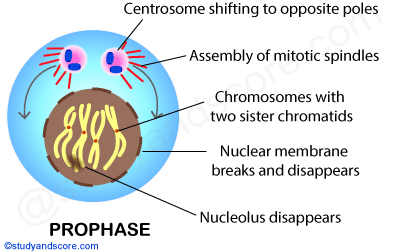
The following are the changes taking place inside the cell during the prophase
- Condensation of chromatin into chromosomes with two sister chromatids attached at centromere
- Nuclear membrane breaks down and disappears into the cytoplasm
- Nucleolus also disappears
- Assembling of mitotic spindle
- Centrosomes move toward opposite poles of the cell
Metaphase
The disappearance of nuclear membrane and nucleolus marks the beginning of metaphase. The chromosomes become shorter by further coiling.
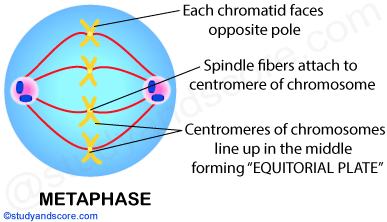
The following are the changes taking place inside the cell during the prophase
- Chromosomes are lined up in the middle of the cell
- Centromeres of the chromosomes are arranged at the equator forming equatorial plate
- Each Chromatid of a chromosome faces the opposite pole
- Spindle fibres arising from the centrioles of the opposite poles are attached to the centromeres. The fibres are made up of proteins rich in sulphur.
Anaphase
The following are the changes taking place inside the cell during the prophase
- Division of centromere marks the beginning of anaphase.
- With the contraction of the spindle fibres, sister chromatids are pulled apart to opposite sides of cell.
- Sister chromatids may assume variable shapes (V or J or I) depending on the position of the centromere.
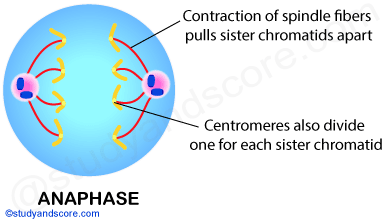
Telophase
The events occurring in the telophase are the reverse of the events in the prophase.
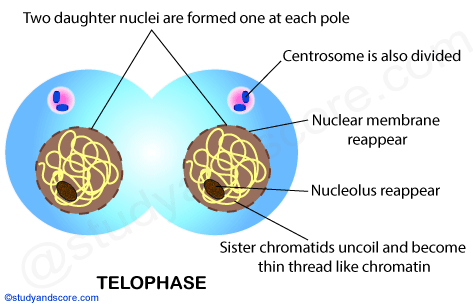
The following are the changes occurring in the cell at the end of anaphase,
- Sister chromatids uncoil, elongate and become thin and invisible after reaching the opposite poles
- The nuclear membrane and the nucleolus reappear.
- Thus, two daughter nuclei are formed, one at each pole.
Cytokinesis
After karyokinesis (nuclear division), the cytoplasm is divided by the formation of the cell wall between the two daughter nuclei. This division of the cytoplasm is called as the cytokinesis.
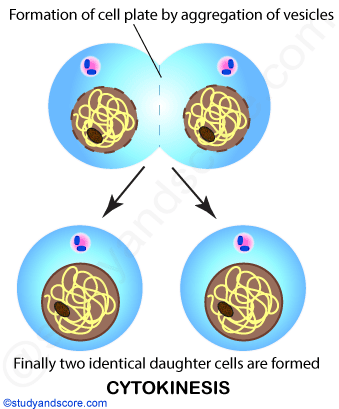
During the last stages of telophase, the cell itself divides. In animal cells, a cleavage plate made of actin and its motor protein constricts the middle of the cell whereas in plants, a structure called the phragmoplast forms at the equator of the spindles where it directs the formation of a new cell wall. Cell plate or phragmoplast is formed by the aggregation of vesicles produced by Golgi bodies. These vesicles which contain cell wall materials fuse with one another to form cell membranes and cell walls. Thus, at the end of mitosis, two identical daughter cells are formed.
SIGNIFICANCE OF MITOSIS
Mitosis plays an important role in the life of living organisms in various ways listed below:
- As a result of mitosis two daughter cells which are identical to each other and identical to the mother cell are formed.
- Mitotic cell division ensures that the daughter cells possess a genetical identity, both quantitatively and qualitatively.
- Mitosis helps to maintain proper size of the cell.
- Mitosis provides the opportunity for the growth and development of organs and the body or organism. Hence it forms the basis of continuation of organisms.
- Asexual reproduction of lower plants is possible only by mitosis. Also, in vegetatively propagated crops like sugarcane, sweet potato, potato, etc., mitosis helps in asexual propagation. Mitosis leads to production of identical progeny in such crops.
- Vegetative reproduction in higher plants by grafting, tissue culture method are also a consequence of mitosis.
- Mitosis is the common method of multiplication of cells that helps in the growth and development of multi-cellular organism.
- Mitosis helps in the regeneration of damaged tissue and in wound healing. Mitosis continuously replaces old tissues with new ones, such as gut epithelium and blood cells.
- The chromosomal number is maintained constant by mitosis for each species.
- After fusion of male and female gametes zygote is formed. Mitosis is responsible for development of a zygote into adult organism.
- In plants, mitosis leads to formation of new parts, viz., roots, leaves, stems and branches. It also helps in repairing of damaged parts.
- Mitosis is useful in maintaining the purity of types because it leads to production of identical daughter cells and does not allow segregation and recombination to occur.

- Give the significance of mitosis in animal cells.
- Write about the importance of mitosis in plant cells.
- Give detailed account of mitotic cell division.
- Write about Metaphase and Anaphase.
- What is the importance of cytokinesis.
- Share with your friends! -






Login to post your comment here...
- or with social Account -